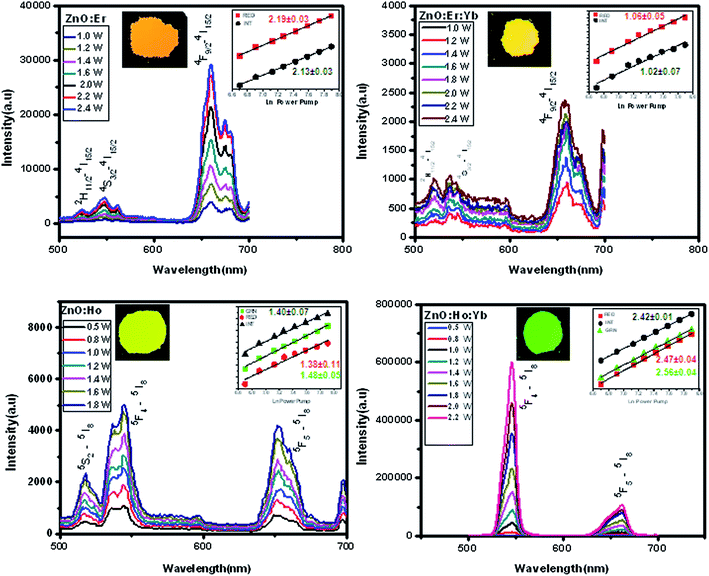Introducing dual excitation and tunable dual emission in ZnO through selective lanthanide (Er3+/Ho3+) doping
Naveen Khichar,
Swati Bishnoi and
Santa Chawla*
Luminescent Materials Group, CSIR-National Physical Laboratory, Dr. K. S. Krishnan Road, New Delhi – 110012, India. E-mail: santa@nplindia.org
First published on 22nd April 2014
Abstract
We have introduced dual excitation properties in the multifunctional semiconductor ZnO by controlled solid state diffusion of dopant lanthanide ions like Er3+ and Ho3+ into the lattice at 500 °C. So far light emission from doped ZnO has been explored either under UV or IR excitation. Our results show that the emission colour can be tuned from cyan to red under UV (band edge, 377 nm) excitation and from green to red under IR (980 nm) excitation in ZnO through selected doping of lanthanide ions. Doping lanthanide ions in ZnO changes its morphology and emission characteristics. Whereas down conversion emission under UV excitation is due to across band gap excitation and subsequent donor–acceptor pair recombination, the dependence of up conversion emission yield on pump laser power indicates that two to three photon processes may be more effective in ZnO hosts for frequency upconversion.
1. Introduction
Rare-earth (RE) ion doped nanomaterials with up-conversion (UC) luminescence have a variety of applications in solid-state lasers, three dimensional displays, solar cells and fluorescence biological labels and have attracted a great deal of attention.1–4 Most such materials comprise complex inorganic hosts of insulators, mainly fluorides. Efficient light emitting properties from RE ions doped in semiconductor nanoparticles has been a challenge. The ZnO crystal, a direct band-gap multifunctional semiconductor with excellent physical and chemical stability has been identified as an efficient light emitter and has received extensive attention in the field of photonic technology.5–15 RE ion doped ZnO have also applications in high power lasers and various optoelectronic devices.16,17 Luminescence studies in ZnO mostly focused on Stokes shifted emission under UV excitation. Reports on anti Stokes UC luminescence in ZnO are sparse e.g., in ZnO:Er3+ and Er3+, Yb3+ codoped ZnO18–21 and in Ho3+ and Yb3+ co-doped ZnO.22 In most UC studies, Yb3+ ion is used as sensitizer for efficient IR absorption and energy transfer processes to RE ion. However, tunability in Stokes shifted luminescence characteristics of ZnO due to doping of Er3+ and Ho3+ under UV excitation has not been investigated.In this work, we provide the first report on dual excitation and dual emission characteristics of RE ion doped ZnO which are excitable by both UV and IR light but exhibit different emission colour depending upon the dopant. ZnO with different rare earth ion doping e.g., ZnO, ZnO:Er3+, ZnO:Er3+, Yb3+, ZnO:Ho3+, ZnO:Ho3+, Yb3+ were synthesized by controlled solid state diffusion at relatively low temperature (500 °C). A detail photoluminescence (PL) spectroscopic study of RE doped ZnO under both UV and IR (980 nm) excitation clearly indicate that they exhibit dual mode luminescence characteristics.
2. Experimental
For preparation of undoped ZnO; ZnO:Er3+ (2 mol%); ZnO:Er3+ (2 mol%), Li (2%); ZnO:Er3+ (2 mol%), Yb3+ (10 mol%); ZnO:Ho3+ (2 mol%) and ZnO:Ho3+ (2 mol%), Yb3+ (10 mol%) by controlled reaction in the solid state, stoichiometric molar compositions of commercial ZnO powder and dopant lanthanide oxide materials Er2O3, Ho2O3, Yb2O3 and LiOH·2H2O were taken according to stoichiometric formula with lanthanide ions as substitutional dopant in zinc position. All the powder precursors were mixed thoroughly in pestle–mortar and then packed in highly pure quartz boat. The material was fired at 500 °C for 2 hours in air atmosphere. The sintered white mass was allowed to cool naturally as slow cooling rate allows uniform temperature distribution throughout the reacting mixture enabling better dopant substitution and luminescence intensity in the product. Finally a white sintered mass is obtained after cooling which is made into powder form by grinding.3. Characterisation
The X-ray powder diffraction (XRD) of the synthesized samples was examined on a Rigaku miniflex X-ray diffractometer using the principle of Bragg–Brentano geometry, with Cu-Kα radiation (1.54 Å). Diffractograms were recorded in grazing incidence geometry. The diffraction angle 2θ was scanned in the range 20 to 80°.The morphology of the synthesized undoped and Lanthanide doped ZnO powder samples were inspected using a LEO 440 PC based digital scanning electron microscope (SEM).
The photoluminescence (PL) down and up conversion properties like excitation, emission spectra and time resolved decay of luminescence were recorded using combined steady state fluorescence and lifetime spectrometer of Edinburgh Instruments FLSP920 with Xe lamp as excitation source for down conversion experiments. For up conversion photo luminescence measurements, a power tunable 980 nm diode laser (MDL-N-980-6W) coupled with optical fibre, was used as excitation source. For measurements of time resolved luminescence decay under UV excitation, microsecond pulsed Xe lamp was used and time correlated single photon counting (TCSPC) technique was used.
4. Results and discussion
4.1 Phase characterization
Phase characterization of all synthesized undoped and lanthanide doped ZnO samples was done by X-ray diffraction and Fig. 1 shows the intensities of main three peaks (100), (002) and (101) corresponding to “wurtzite hexagonal” phase of ZnO (JCPDS Card no. 36-1451). All the peaks of ZnO; ZnO:Er3+; ZnO:Ho3+; ZnO:Ho3+, Yb3+; ZnO:Er3+, Li+ synthesized by SSR method are monophasic and could be indexed to “wurtzite hexagonal” phase of ZnO without any precipitated phase. The sharp peaks of ZnO indicate that the products are well crystallized and that Er3+, Yb3+, Ho3+ and Li+ doping in ZnO does not alter its wurtzite structure. The changes in peak intensities due to Er3+, Yb3+, Ho3+ and Li+ doping indicate that due to doping diffracted peak intensity decreases. A close comparison of the diffraction angle with different doping (Fig. 1) suggests peak shift and hence change in lattices parameters due to substitutional doping of Er3+ (effective ionic radii 0.103 nm), Yb3+ (effective ionic radii 0.101 nm), Ho3+ (effective ionic radii 0.104 nm), in place of Zn2+ (effective ionic radii 0.088 nm). The powder X-ray diffraction spectra of ZnO:Er3+, Yb3+ sample shows poor crystallinity compared to other samples as well as presence of peaks other than ZnO occurring from RE precursors (inset of Fig. 1). The variation of lattice parameters ‘a’ and ‘c’ with doping of Er3+, Yb3+, Ho3+ and Li+ in ZnO is shown in Table 1. As substitutional Er3+ has larger ionic radius (0.103 nm) than Zn2+ (0.088 nm), Er–O bond contraction would result in decrease in crystalline parameters ‘a’ and ‘c’ as evidenced in Table 1. Charge compensation by addition of monovalent Li+, however restores the lattice parameters of undoped ZnO.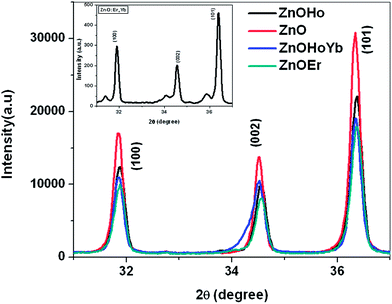 | ||
| Fig. 1 Comparison between XRD patterns of undoped ZnO and ZnO with different rare earth doping, inset shows the XRD spectra of ZnO:Er, Yb. | ||
| Sample | Crystallite parameter | Luminescence decay time τ (microsecond) (relative%) | ||
|---|---|---|---|---|
| Name | a | c | τ1 | τ2 |
| Undoped ZnO | 3.2407 | 5.1922 | 1.35 (30.45%) | 8.47 (69.55%) |
| ZnO:Er3+ | 3.2387 | 5.1864 | 3.51 (24.09%) | 23.68 (75.97%) |
| ZnO:Er3+, Li | 3.2407 | 5.1922 | — | — |
| ZnO:Er3+, Yb3+ | 3.2469 | 5.1907 | 1.636 (31.65%) | 20.58 (68.35%) |
| ZnO:Ho3+ | 3.2387 | 5.1864 | 3.38 (20.54%) | 27.5 (79.46%) |
| ZnO:Ho3+, Yb3+ | 3.2407 | 5.1922 | 1.60 (36.86%) | 23.24 (63.14%) |
4.2 Morphology
The SEM micrographs of ZnO with different rare earth doping are shown in Fig. 2. The pure undoped ZnO sample consist of rounded grains that sometimes coalesce to form a floral morphology, while all the doped ZnO sample exhibit flake like morphology as shown in Fig. 2. As all the samples have been prepared under identical synthesis condition, the change in morphology could only be due to strain induced in the lattice by doping larger RE ions. Dopant induced morphology changes in ZnO have also been reported earlier.23,24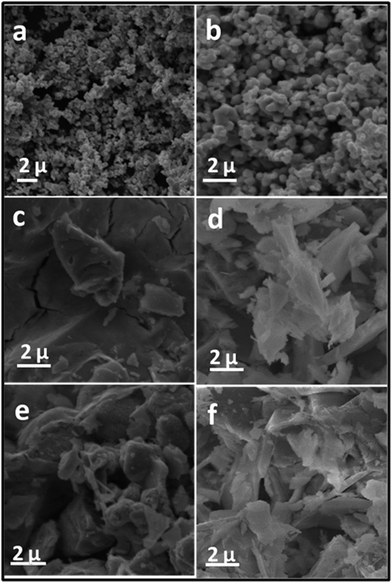 | ||
| Fig. 2 SEM image of (a) ZnO (b) ZnO annealed (c) Er3+ doped ZnO (d) Er3+:Yb3+doped ZnO (e) Ho3+ doped ZnO (f) Ho3+:Yb3+doped ZnO. | ||
4.3 Down conversion luminescence
The photoluminescence excitation and emission spectra (Fig. 3) and corresponding photographs of powder samples under UV (377 nm) excitation displayed as insets clearly reveal the tunable emission from ZnO due to doping of rare earth ions. The excitation spectra shows sharp band edge absorption of ZnO at 377 nm for all undoped as well as doped samples and all PL emission spectra are recorded under 377 nm excitation. Undoped ZnO shows broad blue green (cyan) emission peaking at 505 nm. The intrinsic cyan luminescence of undoped ZnO changes due to lanthanum doping and ZnO:Er3+ sample emits broad red emission peaking at 626 nm and Ho3+ doped ZnO sample emits broad red emission peaking at 619 nm. With addition of co dopant Yb3+, the ZnO:Ho3+, Yb3+ sample also emits in red region with broad emission maxima at 625 nm. The emission under UV excitation originates due to donor–acceptor pair (DAP) recombination between various intrinsic and extrinsic (dopant related) defects. As the trap level energy position changes due to different donor levels corresponding to Er3+, Yb3+ and Ho3+, the broad peak due to DAP recombination shifts. | ||
| Fig. 3 Downconversion emission spectra under UV excitation of undoped and various lanthanide doped ZnO samples. The inset shows the photograph of the samples under UV light. | ||
Charge compensation in ZnO doped with Er3+/Ho3+ and Yb3+ would require that e.g., two Er3+ ions are substituted for three Zn2+ ions. For trivalent state of Er3+ dopant, overall charge neutrality in the lattice could be maintained either by creating one Zn2+ vacancy for incorporation of each two Er3+ ions or introducing one oxygen interstitial (Oi2−) defect in the following manner:
| 3Zn2+ = 2ErZn3+ + VZn2+ | (1) |
| 3Zn2+ = 2ErZn3+ + Zn2+ + Oi2− | (2) |
Both the point defects Vzn (0.3 eV above valence band) and Oi (1.08 eV above the valence band) act as acceptor centres in ZnO,25 but formation probability of interstitial oxygen centres (Oi) is less due to bigger size of oxygen atoms (0.126 nm). On the contrary, as the ZnO samples are synthesized in oxygen rich atmosphere, zinc vacancies are more favourable as they have very low formation energy. VZn centre lies 0.3 eV above ZnO valence band.25 Recombination of electrons from an intrinsic donor level to VZn acceptor centre give rise to blue green (cyan) emission in undoped ZnO (Fig. 3, inset). On doping Er3+/Ho3+ in ZnO, the intrinsic point defects created by trivalent dopants in zinc substitutional position makes donor centres and also enhances the presence of zinc vacancies in the neighbourhood for charge compensation. Recombination between such donor–acceptor pair give rise to red luminescence in Er3+/Ho3+ doped ZnO. The excitation and recombination processes are elucidated in the energy level diagram (Fig. 5).
4.4 Up conversion luminescence
The upconversion photoluminescence emission spectra of rare earth ion doped ZnO samples under different excitation laser (980 nm) power are shown in Fig. 4. The UC spectra of ZnO:Er3+ sample exhibit dominant red emission (peak at 663 nm) corresponding to transition from level 4F9/2–4I15/2 and smaller green emission peaks (at 523 nm and 545 nm). The ZnO:Er3+, Yb3+ sample shows change in the ratio of red and green emission. ZnO:Er3+, Li+ samples show very poor UC emission. ZnO:Ho3+ sample emits green (peak at 545 nm) and red (peak at 652 nm) in comparable proportion resulting in a green yellow fluorescent colour. ZnO:Ho3+, Yb3+ sample shows predominantly green peak at 545 nm yielding green UC fluorescence and about 70 times increase in green UC luminescence is observed due to Yb3+ codoping. Though in most UC phosphors, UC emission intensity increases with Yb3+ codoping, in case of ZnO:Er3+, Yb3+ the UC emission intensity decreased. This has happened due to poor crystallinity of ZnO:Er3+, Yb3+ samples synthesized at 500 °C (shown as inset of Fig. 1) with presence of some unreacted precursors. Due to lattice strain arising from Yb3+ codoping in ZnO:Er3+, ‘a’ and ‘c’ value change to 3.2469 Å and 5.1907 Å compared to that of undoped ZnO – 3.2407 Å and 5.1922 Å (Table 1). Whereas ZnO:Ho3+, Yb3+ samples show very good crystallinity with lattice parameters corresponding well with that of undoped ZnO. Due to this, the PL emission both under UV and IR excitation from ZnO:Er3+, Yb3+ samples are very poor. Moreover, it has also been reported that higher Yb3+ concentration that 5 mol% in ZnO:Er3+, Yb3+ lead to decrease in intensity.21As up conversion emission involves absorption of multiple photons of lower energy (IR) by the phosphor material to emit a single photon of higher energy (visible), the dependence of UC emission intensity (IUC) on the pump IR laser power (Ii) follows a power law represented by IUC ∝ Iin. The upconversion emission efficiency is also dependent upon the non radiative multiphonon relaxation processes that are dependent upon the host lattice. The oxide semiconductor has low phonon energy with a characteristic 440 cm−1 energy corresponding to Zn–O vibrational bond.19 Low phonon energy of the host facilitates the active lanthanide ions to relax to ground state by emitting photons rather than phonons. In order to investigate the multiple photon absorption process in RE ion doped ZnO, the dependence of integrated up-converted emission intensity on IR laser excitation power has been calculated for each sample and is shown as the power pump plot in insets of each UC PL spectra. We have integrated the emission spectra separately under green emission region as well as red emission region and also the total integrated intensity of emission spectra and plotted against the pump laser power.
ZnO:Er3+ samples displays slope of 2.19 ± 0.03 for integrated emission and 2.12 ± 0.02 for only red emission. For the ZnO:Er3+, Yb3+ sample, the integrated emission slope value is 1.26 and red emission slope is 1.24. Similarly for ZnO:Ho3+ sample, the slope values are 1.38 ± 0.11, 1.48 ± 0.05, 1.40 ± 0.07 for red, green and integrated emission respectively. For ZnO:Ho3+, Yb3+ sample, slope values are 2.47 ± 0.04, 2.56 ± 0.04, 2.42 ± 0.01 for red, green and integrated emission respectively. The results indicate that two photon processes are mainly responsible for the observed up-converted emissions in Er3+/Ho3+ doped ZnO. It is also evident for ZnO:Ho3+, Yb3+ samples, the photon yield is very high and slope value is more than 2 suggesting that three photon absorption may be more effective for frequency upconversion process in ZnO host. The UC excitation process from ground state of the RE ion to respective emitting level may involve two to three photons depending upon the concentration of rare earth ions and possible energy transfer and cross relaxation processes between levels. Three photon processes have also been reported for ZnO:Er3+, Yb3+ due to cross relaxation between levels21 and in Y2O3:Er3+, Yb3+,26 in ZrO2:Er3+,27 in NaYF4:Er3+, Yb3+.28
4.5 Energy level diagram
The excitation and emission processes for both down and up conversion luminescence are elucidated in the energy level diagram including the f–f levels of Er3+, Yb3+, Ho3+ ions in Fig. 5. Under 377 nm band edge excitation, electrons excited to the conduction band can relax to various donor levels (intrinsic as well as created by dopant trivalent RE ion) and radiatively recombine with the acceptor centre to produce luminescence as indicated in Fig. 5.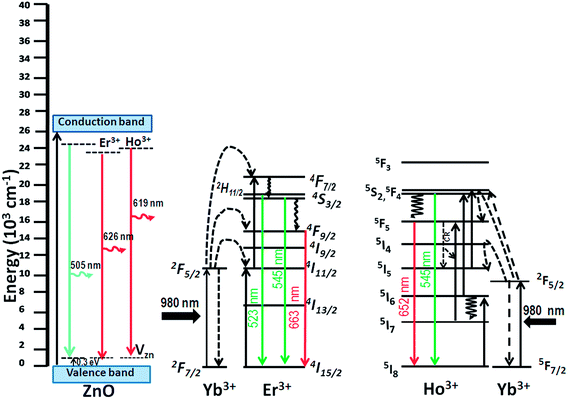 | ||
| Fig. 5 Schematic energy level diagram, showing the DC and UC mechanisms in ZnO nanocrystals doped with Er3+; Er3+, Yb3+; Ho3+; Ho3+, Yb3+ under UV and 980 nm excitation respectively. | ||
Under 980 nm excitation, the emitter Er3+ and Ho3+ ions can directly get excited from their respective ground states to excited state e.g., 4I15/2–4I11/2 (Er3+) and 5I8–5I5 (Ho3+) and then to upper levels by two photon absorption process as the respective level spacing correspond to excitation energy. In UC phosphors, usually Yb3+ is codoped as a sensitizer since Yb3+ ions can resonantly absorb 980 nm photons corresponding to the level spacing 2F7/2 to 2F5/2 and have larger excitation cross section than the emitter such as Er3+ and Ho3+. Yb3+ concentration is usually kept higher to ensure more number of Yb3+ ions on the 2F5/2 excited state. Upon irradiation by 980 nm laser, two Yb3+ ions resonantly absorb two IR photons and reach 2F5/2 excited state when one Yb3+ ion transfers energy to the second Yb3+ ion (Fig. 5) to go back to ground state 2F7/2. The excited Yb3+ ion non-radiatively transfers the energy to neighbouring Ho3+ ions exciting them to various upper levels from their respective ground state. Er3+ and Ho3+ ions emitting multiband light with Yb3+ acting as a sensitizer has been reported in many papers.29–31 The upconversion emission in Er3+ are explained by several mechanisms such as19 (a) Excited State Absorption (ESA) (b) Energy Transfer (ET) (c) Photon Avalanche (PA). In the present case, since no power threshold was observed, PA mechanism can be ruled out. For Yb3+ sensitized samples, the excited Yb3+ ion transfer its energy to Er3+ ions, Er3+ then undergoes 4I15/2–4I11/2 and 4I11/2–4F7/2 transition. Due to nonradiative process involving lattice phonons in Er3+ the electron in the 4F7/2 state undergo nonradiative decay to 2H11/2, 4S3/2 and 4F9/2 level.20 Finally in emission process the excited electrons in 4S3/2, 4F9/2, 2H11/2 transit back to 4I15/2 ground state giving rise to Er3+ emission peaks at 525 nm, 545 nm and 663 nm. For only Er3+ doped ZnO, since the red emission is dominant, the population of 4F9/2 level is high which could happen through ground state absorption from 4I15/2 level, excited state absorption from 4I11/2 and some cross relaxation between 4F7/2 and 4I11/2 levels as this provides a low energy loss (80 cm−1) pathway18 compared to multiphonon relaxation from 4F7/2 level as the energy gap is high.
In Yb3+, Ho3+ system, excited sensitizer ion Yb3+ transfer energy to Ho3+ ion exciting them to higher levels. Two consecutive ET from Yb3+ to Ho3+ can raise the Ho3+ ions to the 5S2, 5F4 levels and the green emission occurs when Ho3+ ions in the 5S2, 5F4 levels relax to ground state 5I8 by emission of green photons (Fig. 5). ESA from Ho3+ 5I6–5S2 can also raise the emitting Ho3+ ions to the green emitting level as the pump laser energy matches well with the level spacing. Due to large population in 5S2, 5F4 levels, the green emission intensity is high. The non radiative relaxation probability from 5S2, 5F4 level to lower 5F5 level depends upon the host phonon energy and the red emission at 652 nm happens due to 5F5–5I8 transition. The non radiative transition to 5F5 level reduces drastically upon codoping Yb3+ ions and the green emission becomes very dominant with much higher emission intensity. The red emitting 5F5 level may be populated by 5I7–5F5 absorption,32 cross relaxation (CR) may also happen due to ion–ion interaction. From the slope of pump power plot, the UC process in ZnO:Ho3+ (slope ∼1.5) is a two photon process whereas in ZnO:Ho3+, Yb3+ (slope ∼2.5) is two to three photon process for excitation to 5S2, 5F4 levels and predominant green emission.
The UC and DC spectra described above clearly indicate that rare earth metal ions Er3+/Ho3+ doped ZnO exhibit dual mode luminescence characteristics. They are excitable by UV as well as IR light and the emission spectra also differ.
4.6 Chromaticity of the lanthanide doped dual excitation ZnO
The chromaticity co-ordinates of both DC and UC emission for undoped and lanthanide doped ZnO samples have been calculated from their respective emission spectra according to the procedures of Commission of International de L'Eclairage (CIE), France.33 The colour coordinates of each sample under UV (DC) and IR (UC) excitation is shown in the chromaticity diagram Fig. 6(a) which clearly indicate that due to lanthanide doping in ZnO, the DC emission can be tuned from cyan to red and UC emission from green to orange red.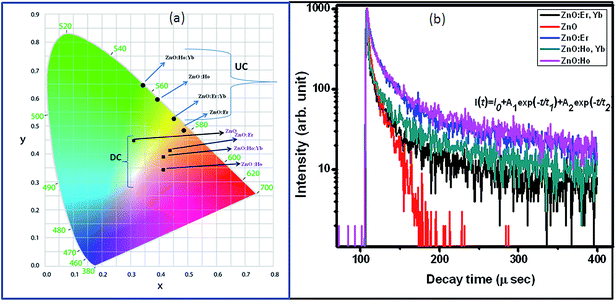 | ||
| Fig. 6 (a) Colour coordinates of DC (under UV excitation) and UC (under IR excitation) and (b) luminescence decays of ZnO and ZnO doped with various lanthanide dopants. | ||
4.7 Time resolved luminescence decay
Time resolved luminescence decay of undoped and ZnO doped with different rare earth ions under UV (377 nm) excitation is shown in Fig. 6(b). The decay is in microsecond range and the decay curves can be fitted into bi exponentials. The decay times are indicative of donor–acceptor pair recombination. It can be noted that undoped ZnO sample has comparatively fast decay, doping increases its decay time as shown in Fig. 6(b). The decay times of each sample at peak emission wavelength under UV excitation and relative contribution of each component are listed in Table 1.5. Conclusion
Controlled solid state diffusion of trivalent lanthanide ions in ZnO at relatively low temperature (500 °C) lead to formation of ZnO; ZnO:Er3+; ZnO:Er3+, Yb3+; ZnO:Ho3+; ZnO:Ho3+, Yb3+ nano and microcrystals with varied morphology. Whereas undoped ZnO synthesized in identical conditions yield cyan fluorescence, Er3+/Ho3+ doping changes the fluorescence colour to different hues of red under band edge (377 nm) UV excitation. RE doped ZnO samples exhibit UC luminescence with colour ranging from green to orange red due to different emission ratio of green and red depending upon the light emitting ion Er3+/Ho3+ and sensitizer Yb3+. The results conclusively show that ZnO can function as a phosphor in dual excitation mode of both down and up conversion at the same time and the emission can be tuned widely in the visible range through trivalent lanthanide doping. Such ZnO samples with dual excitation and tunable dual emission have immense potential in light emitting devices and solar cell applications.Acknowledgements
This present work was supported by the TAPSUN project under CSIR Solar Mission program of India.References
- E. Downing, L. Hesselik, J. Raltson and R. Macfarlance, Science, 1996, 273, 1185 CAS
.
- F. Van de Rijke, H. Zijlmans, S. Li, T. Vail, A. K. Raap, R. S. Niedbala and H. J. Tanke, Nat. Biotechnol., 2001, 19, 273 CrossRef CAS PubMed
.
- G. S. Yi, H. C. Lu, S. Y. Zhao, G. Yue, W. J. Yang, D. P. Chen and L. H. Guo, Nano Lett., 2004, 42, 191 Search PubMed
.
- L. Wang, R. X. Yan, Z. Y. Hao, L. Wang, J. H. Zeng, J. Bao, X. Wang, Q. Peng and Y. D. Li, Angew. Chem., Int. Ed., 2005, 44, 6054 CrossRef CAS PubMed
.
- B. Y. Oh, M. C. Jeong, T. H. Moon, W. Lee, J. M. Myoung, J. Y. Hwang and D. S. Seo, J. Appl. Phys., 2006, 99, 124505 CrossRef PubMed
.
- A. Gupta and A. D. Compaan, Appl. Phys. Lett., 2004, 85, 684 CrossRef CAS PubMed
.
- Z. L. Wang, Annu. Rev. Phys. Chem., 2004, 55, 159 CrossRef CAS PubMed
.
- C. S. Rout, A. R. Raju, A. Govindaraj and C. N. R. Rao, Solid State Commun., 2006, 138, 136 CrossRef CAS PubMed
.
- Z. L. Wang, C. K. Lin, X. M. Liu, Y. Luo, Z. W. Quan, H. P. Xiang and L. Lin, J. Phys. Chem. B, 2006, 110, 9469 CrossRef CAS PubMed
.
- G. Seisenberger, M. U. Ried, T. Endress, H. Buning, M. Hallek and C. Brauchle, Science, 2001, 294, 1929 CrossRef CAS PubMed
.
- J. M. Daewas, P. Dekker, P. Burns and J. A. Piper, Opt. Rev., 2005, 12, 101 CrossRef PubMed
.
- G. S. Yi, B. Q. Sun, F. Z. Yang, D. P. Chen, Y. X. Zhou and J. Cheng, Chem. Mater., 2002, 14, 2910 CrossRef CAS
.
- S. Heer, K. Kompe, H. U. Gudel and M. Haase, Adv. Mater., 2004, 16, 2102 CrossRef CAS
.
- M. U. Staudt, S. R. Hastings-Simon, M. Nilsson, M. Afzelius, V. Scarani, R. Ricken, H. Suche, W. Sohler, W. Tittel and N. Gisin, Phys. Rev. Lett., 2007, 98, 113601 CrossRef CAS
.
- H. Desirena, E. De la Rosa, A. L. Diaz-Torres and A. G. Kumar, Opt. Commun., 2006, 281, 560 Search PubMed
.
- J. S. John, J. I. Coffer, Y. Chen and R. F. Pinnizzotto, Appl. Phys. Lett., 2000, 77, 1635 CrossRef PubMed
.
- R. Deng, X. T. Zhang, E. Zhang, Y. Liang, Z. Liu and H. Xu, et al., J. Phys. Chem. C, 2007, 111, 13013 CAS
.
- Y. Liu, Q. Yang and C. Xu, J. Appl. Phys., 2008, 104, 064701 CrossRef PubMed
.
- X. Wang, X. Kong, G. Shan, Y. Yu, Y. Sun, L. Feng, K. Chao, S. Lu and Y. Li, J. Phys. Chem. B, 2004, 108, 18408–18413 CrossRef CAS
.
- L. Wang, X. Wang, Z. Li, P. Liu, F. Liu, F. Song, S. Ge, B. Liu, Y. Shi and R. Zhang, J. Phys. D: Appl. Phys., 2011, 44, 155404 CrossRef
.
- Y. Bai, Y. Wang, K. Yang, X. Zhang, Y. Song and C. H. Wang, Opt. Commun., 2008, 281, 5448–5452 CrossRef CAS PubMed
.
- X. Yun, S. Liang, Z. Sun, Y. Duan, Y. Qin, L. Duan, H. Xia, P. Zhao and D. Li, Opt. Commun., 2014, 313, 90–93 CrossRef PubMed
.
- K. Jayanthi, S. Chawla, K. N. Sood, M. Chhibara and S. Singh, Appl. Surf. Sci., 2009, 255, 5869–5875 CrossRef CAS PubMed
.
- K. Jayanthi, S. Chawla, A. Joshi, Z. H. Khan and R. K. Kotnala, J. Phys. Chem. C, 2010, 114, 18429–18434 CAS
.
- B. Lin, Z. Fu and Y. Jia, Appl. Phys. Lett., 2001, 79, 945 Search PubMed
.
- X. Bai, H. Song, G. Pan, Y. Lei, T. Wang, X. Ren, S. Lu, B. Dong, Q. Dai and L. Fan, J. Phys. Chem. C, 2007, 111, 13611–13617 CAS
.
- L. A. D. Torres, E. D. L. R. Cruz, P. Salas and C. A. Chavez, J. Phys. D: Appl. Phys., 2004, 37, 2489–2495 CrossRef
.
- J.-C. Boyer, L. A. Cuccia and J. A. Capobianco, Nano Lett., 2007, 7, 847–852 CrossRef CAS PubMed
.
- D. Matsuura, Appl. Phys. Lett., 2002, 82, 4526 CrossRef PubMed
.
- G. Y. Chen, Y. G. Zhang, G. Somestalean, Z. G. Zhang, Q. Sun and F. P. Wang, Appl. Phys. Lett., 2006, 89, 163105 CrossRef PubMed
.
- F. Vetrone, J. C. Boyer, J. A. Capobianco, A. Speghini and M. Bettineli, Appl. Phys. Lett., 1752, 2002, 80 Search PubMed
.
- X. X. Luo and W. H. Cao, Mater. Lett., 2007, 61, 3696–3700 CrossRef CAS PubMed
.
- Kelmer, Luminescent Screens: Photometry and Colorimetry 118, Iliffe, London, 1969 Search PubMed
.
| This journal is © The Royal Society of Chemistry 2014 |

